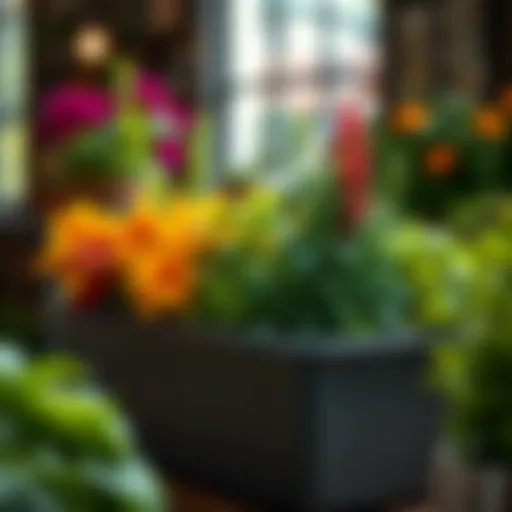Exploring Large Outdoor Plant Pots: A Comprehensive Guide
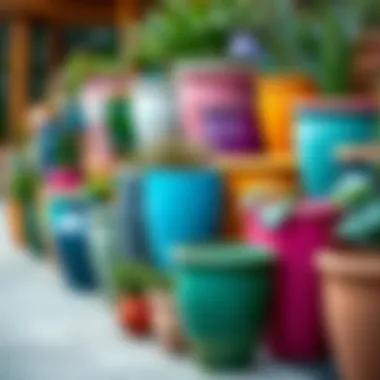

Intro
Large outdoor plant pots are becoming a staple in many gardens and landscapes today. These pots do more than merely hold soil and plants; they serve as design features that can elevate the aesthetic appeal of any outdoor space. Whether you're looking to add a touch of greenery to a balcony or create a vibrant focal point in a garden, the right pot can make all the difference.
Understanding the various aspects of large outdoor plant pots is essential for homeowners, gardeners, and anyone passionate about enhancing their outdoor areas. From selecting the right materials to understanding different styles and maintenance needs, there’s a lot to consider. Problems like drainage issues or unsuitable materials can hinder plant health and ultimately ruin your investment.
This comprehensive guide aims to illuminate the various facets of large outdoor plant pots, focusing on their significance, styles, purchasing guide, and care strategies. By the end of this guide, readers will not only know which type of pot suits their plants and space best, but also how to keep their selections looking fresh and vibrant for years.
Furniture Trends and Styles
The world of gardening isn't just about plants; it's also about the pots that house them. Just like any piece of furniture, outdoor plant pots reflect trends that can change with the seasons, and various styles offer unique characteristics to suit personal tastes.
Current Trends in Pot Design
In recent years, sustainability has taken center stage. Many pot manufacturers are focusing on using eco-friendly materials, such as recycled plastics and sustainably sourced woods. The trend is moving towards minimalist designs that emphasize natural beauty and harmonious shapes. Moreover, self-watering pots are gaining popularity as they make plant care much easier, perfect for busy individuals or those who travel frequently.
- Textured Finishes: Many pots now feature rugged textures, providing an earthy feel that complements the vibrant colors of plants.
- Colorful Glazes: Bright ceramic glazes are popular for adding a splash of vibrancy and character to outdoor spaces, especially in eclectic garden designs.
- Geometric Shapes: Modern designs often showcase angular forms, breaking away from the traditional round pots and allowing for more innovative arrangements.
Popular Pot Styles and Their Characteristics
Different styles of pots can drastically influence the character of your garden. Here’s a rundown of popular styles:
- Terracotta Pots: Classic and timeless, these pots allow for good breathability but can be fragile in colder climates.
- Ceramic Pots: Often adorned with glazes, these pots are available in myriad designs, making them perfect for decorative purposes.
- Wooden Planters: They add a rustic feel and are great for larger plants. However, being exposed to the elements can lead to rot if not treated.
- Concrete Planters: Very sturdy and heavy, these pots are perfect for larger plants but can be a bit harder to move around.
"Choosing the right style of pot is not just about aesthetics; it’s also about functionality and how well it matches the plant you intend to grow."
In terms of trends, more homeowners are opting for larger pots that allow for combinations of plants or even small trees. This not only maximizes the use of available space but also creates stunning visual displays.
Buying and Maintenance Guides
Essential Tips for Purchasing Pots
When considering the purchase of large outdoor plant pots, keep the following in mind:
- Size Matters: Ensure the pot size fits the plant’s mature size. A pot that is too small will restrict growth.
- Check Drainage: Always opt for pots with proper drainage holes. Overwatering is a common issue for many budding gardeners.
- Material Selection: Think about where you live—certain materials cope better with extreme temperatures.
- Weight Consideration: Heavier pots offer stability; however, they can be tough to relocate. Choose what fits your intentions.
- Style Compatibility: Make sure the design aligns with your overall garden theme for a cohesive look.
Maintenance and Care for Different Pot Materials
Each type of pot demands its own care regimen:
- Terracotta: Regular cleaning is necessary to avoid mineral buildup, particularly if using hard water.
- Ceramic: While durable, these need to be checked for chips that may lead to cracks.
- Wooden: Apply weather-sealant for outdoor use to prolong lifespan.
- Concrete: Periodic cleaning and resealing can prevent moisture damage.
In summary, selecting the right pot is a nuanced task that intermingles aesthetic desires with functional needs. Through understanding trends, styles, and maintenance, anyone can transform their outdoor spaces into masterpieces.
Prelude to Large Outdoor Plant Pots
Large outdoor plant pots serve not just as containers for plants—they play a pivotal role in the aesthetics and functionality of outdoor spaces. They can transform a plain patio into a botanical haven or give that empty corner a vibrant splash of color. For homeowners, understanding their importance encompasses practical benefits and those related to design.
A well-chosen large pot can be the difference between a labored gardening experience and a thriving green oasis. These pots have the capacity to hold substantial soil volume, allowing plants to establish deeper roots. This not only aids in water retention but also promotes healthier growth, so the gardener spends less time fussing with watering and hoping for the best.
Moreover, they come in various materials, giving homeowners flexibility in choosing pots that align with their outdoor decor. From classy ceramics to resilient plastics, the choices are vast. Selecting the right pot can complement architectural styles and add personal flair to any space, making gardening a deeper form of self-expression.
As we delve into this guide, we will explore various aspects related to large outdoor plant pots. Understanding these elements can enhance any gardening effort, elevating it from a mere hobby to a passionate endeavor.
Importance of Outdoor Plant Pots
The significance of outdoor plant pots stretches beyond their primary function of holding plants. They can act as focal points in a garden, creating inviting areas that draw the eye. With an array of styles and materials available, the right choice can harmonize with existing landscaping or stand out as a statement piece.
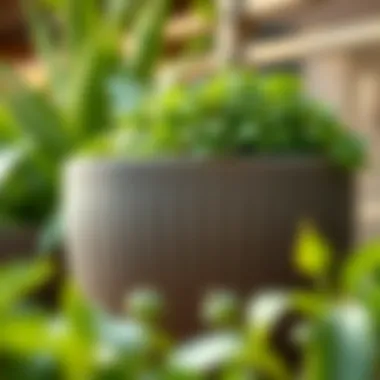
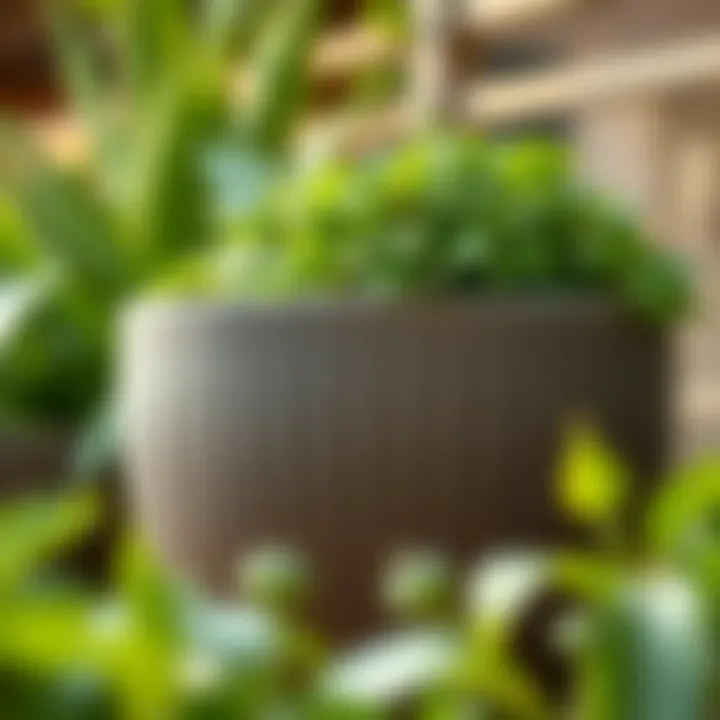
- Functionality: Large pots can simplify gardening practices. They are ideal for those with limited space, allowing for vertical gardening or the growth of larger plants in confined areas.
- Sustainability: Many outdoor pots can be reused or recycled, aligning with sustainable gardening practices. This encourages an eco-friendly approach, inviting more gardeners to consider the environment in their planting choices.
- Ease of Mobility: Unlike planted beds, large outdoor pots are easily movable. This allows homeowners to experiment with arrangements, finding ideal placements for sunlight or aesthetics without heavy lifting.
"A well-placed pot can change the whole atmosphere of a backyard, infusing life into even the dullest of landscapes."
Overview of Planting Options
When it comes to planting in large outdoor pots, the variety of options is extensive. A large pot's volume provides an excellent environment for diverse plants—from vibrant flowers to lush herbs, the possibilities are practically endless.
- Annuals and Perennials: Flower pots are perfect for growing both annuals, which need to be replanted each year, and perennials that come back season after season.
- Vegetables and Herbs: Container gardening allows for fresh produce, even in limited spaces. You can grow tomatoes, peppers, and various herbs with ease.
- Shrubs and Small Trees: Larger pots accommodate shrubs and miniature trees, offering height to garden designs and acting as eye-catching elements.
Each option has its requirements—including watering frequency and sunlight needs—so understanding what type of plant thrives in which conditions is crucial. In the end, a successful planting strategy will enhance the garden's beauty and contribute to the overall plant health, making it a joyful pursuit.
Material Choices for Large Outdoor Plant Pots
When it comes to large outdoor plant pots, material choice plays a pivotal role. Each type of material comes with its own set of characteristics that affect not only the aesthetics but also the longevity and functionality of pots in various environments. Homeowners make selections based not only on visual appeal but also on practical considerations like weight, insulation properties, and drainage capabilities. Choosing the right material is essential for ensuring that your plants thrive and that the pots withstand outdoor conditions.
Ceramic Options and Benefits
Ceramic pots have long been a favorite among gardening enthusiasts. These pots can range from simple to beautifully hand-painted designs, making them a very attractive choice for many gardens. One of the standout benefits of ceramic is their natural insulation properties — they keep the soil temperature constant, protecting the roots from extreme heat or cold.
However, it’s worth noting that ceramic can be quite heavy. For large pots, this might mean needing extra effort to move them around, especially if the plants grow larger over time. Additionally, ceramic pots tend to be porous, which allows for breathable soil but can also lead to greater evaporation of moisture, necessitating more frequent watering. Proper placement of ceramic pots in shaded areas can help mitigate this.
"Ceramic pots are a mix of beauty and function; their presence alone can elevate your entire garden space."
Plastic Pots: Pros and Cons
Plastic pots are a popular and practical option. They are lightweight, making them easy to transport and rearrange as needed. This convenience is particularly beneficial for those who like to change their garden layout frequently or for DIYers who enjoy trying new designs. Moreover, affordable plastic pots come in a variety of colors and shapes, which can easily match any aesthetic.
On the flip side, plastic can sometimes give off a less sophisticated look compared to materials like ceramic or stone. Rain and sun exposure can also lead to fading over time, affecting the overall appearance. A major consideration with plastic is the lack of insulation; without any natural cooling properties, plants can suffer from heat stress during the hotter months if not monitored carefully. Being mindful of watering and choosing thicker-walled pots can help mitigate some of these issues.
Metal and Stone Pots: Aesthetic Appeal
Metal and stone pots bring a unique flair to outdoor spaces. Stone pots, often made from materials like granite or concrete, offer immense durability and are not easily tipped over in high winds. Their natural stone appearance offers an attractive rustic charm that blends seamlessly with many garden designs. However, stone pots can be extremely heavy, making them less ideal for those who might need to relocate their plants.
Metal pots, on the other hand, can provide a sleek and modern look. They are often made from aluminum or galvanized steel, with a shiny finish that catches the eye. One concern, though, is their tendency to heat up in direct sunlight, which can overheat the soil and stress plants. Using insulation techniques, such as a liner inside the pot, can alleviate this problem and provide an extra layer of protection for your plants.
Both metal and stone options will generally hold up well against the elements, ensuring that they remain a permanent feature in your landscape for years to come.
In summary, selecting the right material for large outdoor plant pots is about balancing aesthetics, functionality, and the specific needs of your plants. By understanding the unique properties of each option, homeowners can make more informed choices that will enhance their outdoor spaces.
Styles and Designs of Large Outdoor Plant Pots
When it comes to enhancing outdoor spaces, the styles and designs of large outdoor plant pots play a critical role. These aren't just utilitarian objects; they embody the essence of your garden's aesthetic and contribute significantly to the overall atmosphere. A well-chosen pot can elevate the beauty of your plants, complement architectural features, and serve as a focal point in any landscape. It's about harmonizing elements to create a cohesive visual narrative.
Modern and Minimalist Trends
In today’s fast-paced world, simplicity often reigns supreme. The modern and minimalist approach to outdoor plant pots reflects this ethos. These pots are typically characterized by clean lines, subtle colors, and an overall understated elegance. Think of a large, cylindrical container in a matte grey that contrasts beautifully with vibrant green foliage. The beauty lies in the pot's simplicity, allowing the plant itself to take center stage.
- Key Features:
- Materials: Often made from materials like fiberglass or smooth ceramics that enhance their sleek appearance.
- Colors: Neutral shades such as white, black, and earth tones dominate, creating a timeless look.
- Shapes: Geometric forms, like squares or circles, punctuate modern landscapes effectively.
Incorporating modern pots can transform an otherwise ordinary patio into a chic sitting area. They merge seamlessly with contemporary outdoor furniture, reinforcing a coherent design language that balances sophistication with nature's beauty.
Traditional and Rustic Styles
In contrast to the minimalist style, traditional and rustic pots evoke a sense of nostalgia and warmth. These designs often reflect cultural heritage and natural textures, introducing a charming, organic feel.
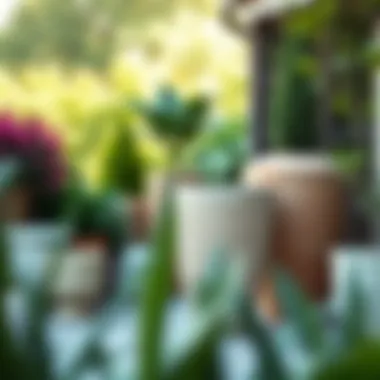
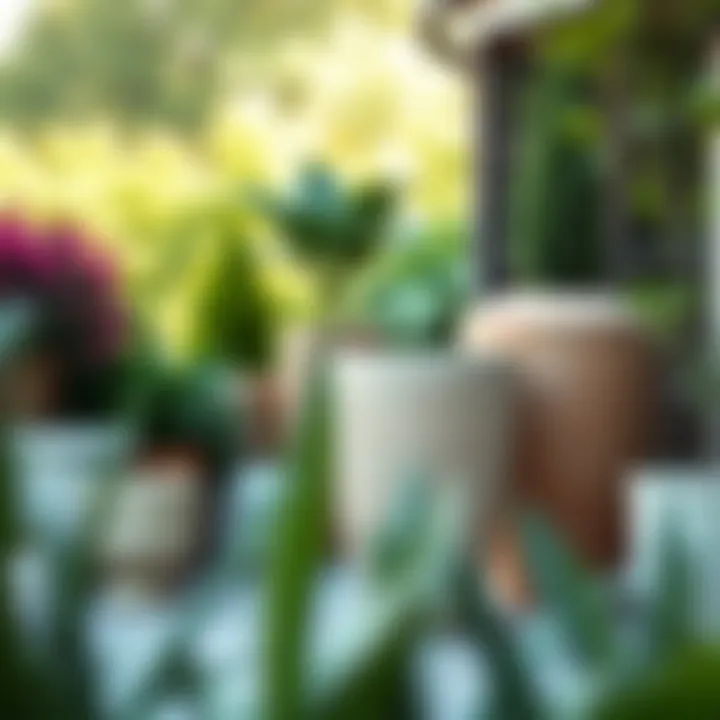
- Common Characteristics:
- Materials: Often made from terracotta, stone, or weathered wood, these materials offer a tactile quality that pairs beautifully with nature.
- Details: Intricate carvings, rough-hewn finishes, and aged patinas give these pots character.
- Colors: Earthy tones—think soft browns, deep greens, or terracotta reds—are common, resonating with an inviting atmosphere.
When positioned in verdant garden settings, these pots create a story. They merge with flowers, herbs, and shrubs, evoking the feeling of a quaint countryside. They might even remind one of old-world charm found in rustic cottages, making them perfect for gardens that celebrate heritage.
Creative and Artistic Variations
For those who cherish uniqueness, creative and artistic pot designs offer endless possibilities. Artistic pots can range from whimsically painted containers to sculptural pieces that double as art installations.
- Varieties:
- Hand-painted Designs: Individual artistic expressions transform pots into vibrant works of art that showcase the owner's personality.
- Sculptural Forms: These pots break conventional shapes, focusing on curves, abstract patterns, and asymmetrical designs.
- Mixed Media: Incorporating materials like metal, glass, or recycled elements adds layers to the pots, engaging viewers on many levels.
"A pot is not merely a vessel; it can narrate the dynamics between artistry and nature."
In a space adorned with creative pots, the ambiance becomes one of playful energy and inspiration. It fosters a unique dialogue between the viewer and the plant life, encouraging a connection that is both personal and communal.
Each style carries its own charm and appeal, aiming to resonate with different tastes and environmental contexts. Therefore, understanding these diverse styles allows homeowners and designers alike to make informed decisions, ensuring that the selected pots enhance not just the aesthetic but the very essence of outdoor living.
Factors to Consider When Buying Large Outdoor Plant Pots
Choosing the right large outdoor plant pots can be a daunting endeavor if one doesn't know what specifics to keep an eye on. It's not simply about picking something that looks pretty; there are critical elements that must align with your gardening goals and the overall aesthetics of your outdoor space. Selecting the perfect pot is a balance of form and function, and certain factors play a significant role in this decision. With the right understanding of these parameters, you can enhance not just the health of your plants but also the visual appeal of your garden.
Size and Capacity Requirements
When searching for large outdoor pots, the size and capacity of the vessel become foundational aspects. A pot that is too small can restrict root development and limit plant longevity. On the flip side, oversized pots can lead to unnecessary water retention, causing root rot.
A good rule of thumb is to select pots that are at least twice the size of the plant’s current pot.
Additionally, consider the mature size of the plant species you intend to pot. Here are points to bear in mind:
- Plant Type: Different plants have varying space needs. For instance, a broad shrub may require more soil volume than a small flowering annual.
- Root Depth: Survey the root system's natural depth for optimal growth; a pot that accommodates this could significantly benefit plant health.
- Mobility: If you anticipate needing to move your plants seasonally, adjust your size choice to lightweight but adequately sized pots.
Drainage Features Ensuring Plant Health
Drainage is a non-negotiable feature when it comes to pots. Without proper drainage, excess water can accumulate, which is detrimental to root health. Among the important factors to scrutinize are:
- Drainage Holes: Make sure that the pot features several holes at the bottom. This allows excess water to escape and prevents standing water.
- Drainage Layer: Consider using gravel or stones at the bottom of the pot to enhance water flow. This keeps the plant roots from sitting in water.
- Material Permeability: Certain materials like terracotta offer breathability, allowing moisture to escape, helping prevent oversaturation.
Weather Resistance and Durability
Durability is critical since outdoor pots are often exposed to varying weather conditions. The pots must withstand elements without cracking, warping, or fading. Weather resistance can influence the longevity of your pots. Here’s what to consider:
- Material Choices: Materials like fiberglass and heavy-duty resin are designed to endure outdoor conditions, resisting material fatigue over time.
- UV Protection: Look for pots that have UV protection if they are made from plastic. This prevents colors from fading due to sun exposure.
- Cold Climate Resilience: If you live in colder regions, choose pots that can resist cracking due to freezing temperatures. Certain stone and ceramic pots have a higher chance of surviving harsh conditions.
Taking into account size, drainage, and weather durability will steer you toward a plant pot that enhances both the health of your flora and the allure of your garden. Knowledge is power, and being mindful of these considerations equips you to make an informed choice in your quest for the perfect large outdoor plant pots.
Care and Maintenance of Outdoor Plant Pots
When it comes to maintaining a vibrant garden, the aspect of care and maintenance of outdoor plant pots often doesn’t receive the attention it deserves. Just like a car needs regular tune-ups, your plant pots need upkeep to ensure they're performing at their best, contribute to plant health, and enhance your outdoor aesthetics. Neglecting this crucial step can lead to unsightly, damaged, or even malfunctioning pots that detract from the beauty of your landscape.
Maintaining your large outdoor plant pots effectively prolongs their lifespan, preserves their appearance, and keeps your plants flourishing. Understanding proper care techniques is key for homeowners and gardening enthusiasts alike. Let’s dive into the specifics, focusing on cleaning techniques and how to prevent wear and tear over time.
Cleaning Techniques and Frequency
Keeping your large outdoor plant pots clean is essential not only for aesthetic appeal but also for promoting the health of your plants. Dirty pots can harbor pests and diseases that can spread to your plant. The good news is that cleaning pots doesn’t have to be a chore—it can easily fit into your gardening routine.
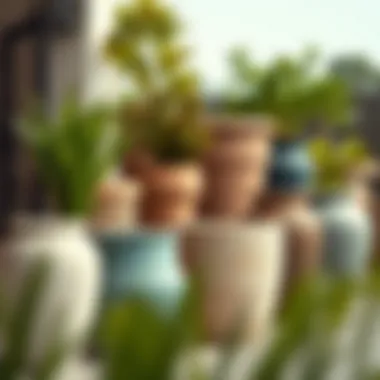
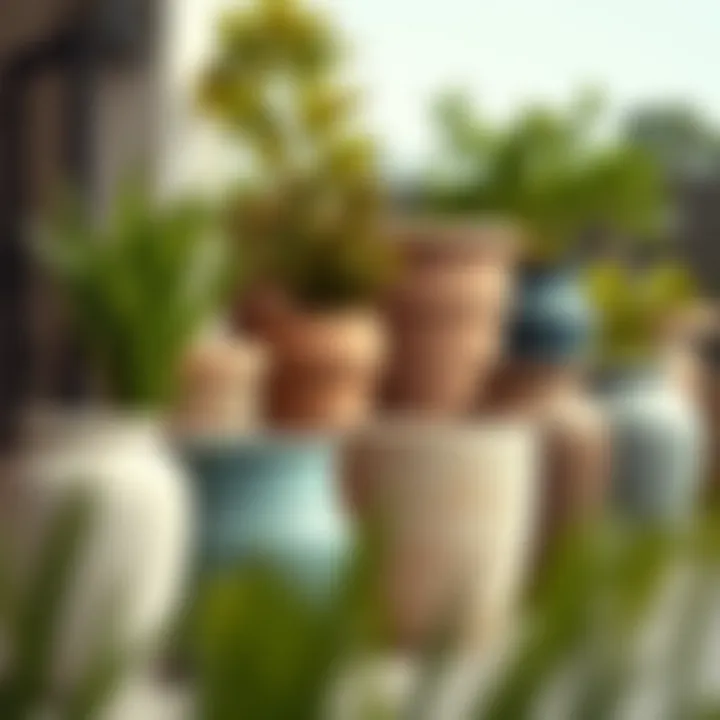
- Frequency of Cleaning: It's wise to give your pots a thorough cleaning at least once a season. However, if you notice algae, mold, or residues from last year’s plant, tackle it right away. Continuous oversight will go a long way in ensuring a healthy environment for your plants.
- Cleaning Techniques:
- Avoiding Harsh Chemicals: Harsh chemicals can damage pots and harm plants. Stick to eco-friendly options whenever possible to keep your garden area safe.
- Soapy Water Solution: Use a mild detergent mixed with warm water. Scrub the surfaces with a soft brush, ensuring to reach any crevices where dirt and grime might hide.
- Vinegar Solution: For tough stains or mineral buildup, a solution of equal parts vinegar and water can be highly effective. Let it sit for a few minutes before scrubbing.
- Rinsing Thoroughly: Always rinse the pots well after cleaning to remove any chemical residues before refilling them with soil and plants.
A simple cleaning routine can tremendously impact the longevity and health of your outdoor pots, keeping the whole space inviting.
Preventing Wear and Tear Over Time
Even the sturdiest pots can show wear and tear over time. Addressing this issue isn’t merely about aesthetics; it's crucial for the welfare of the plants housed inside them.
- Positioning: Be intentional about where you place your pots. Exposure to harsh weather and direct sunlight can lead to cracks and fading. Consider using patio furniture pads or moving pots into shaded areas occasionally.
- Seasonal Adjustments: During colder months, if possible, try to relocate certain pots indoors or to a sheltered area. This helps prevent frost damage, particularly in regions where the temperatures drop significantly.
- Repair Minor Damage Promptly: Small cracks or chips can be repaired using sealant specific for the material of the pot. Don’t let minor issues evolve into major problems that could compromise the structure.
- Storage During Off-Season: If you’re using terracotta or ceramic pots, it’s prudent to store them in a dry, sheltered space during the winter months. This prevents freezing and potential cracking from moisture expansion.
By taking these considerations into account, you not only maintain the aesthetics of your pots but also ensure a conducive environment for your plants.
Regular care and maintenance of outdoor plant pots is not just about beauty; it’s about nurturing the plants and the environment they thrive in.
In summary, being proactive with your outdoor plant pots can save you money in replacements down the line while boosting the spirits of your plants. After all, a well-maintained pot could be compared to a cozy, tidy home—everyone flourishes better in a clean environment.
Integrating Large Outdoor Plant Pots into Landscape Design
Integrating large outdoor plant pots into landscape design is like putting the cherry on top of a beautiful sundae. Not only do these pots serve an essential role in showcasing plants, but they also enhance the visual dynamics of outdoor spaces. The beauty of incorporating these pots lies in their ability to transform ordinary areas into intriguing landscapes. By selecting the right pot style and strategically placing them, homeowners and designers can create captivating focal points that draw the eye and hold attention.
Creating Focal Points in Gardens
When it comes to garden layouts, creating focal points is paramount. Large outdoor plant pots can serve as magnificent centerpieces, pulling together various elements of the landscape into a cohesive design. Imagine a vibrant red ceramic pot filled with cascading petunias situated at the end of a gravel pathway, signaling the completion of the journey through the garden.
Here are a few effective ways to use plant pots as focal points:
- Color Coordination: Choose pots that complement both the flora and the broader landscape. A bright-colored pot can contrast beautifully against greenery, making it stand out remarkably.
- Height Variation: Utilizing pots of different heights creates depth. Consider positioning a tall, narrow pot next to a low, wide one to add interest and intrigue, leading the observer through the garden.
- Grouping for Impact: Arranging several pots in clusters can amplify the visual appeal. For instance, placing three pots together at varying heights can create a mini landscape that captivates.
Creating these focal points not only enhances aesthetics but also makes a garden feel more inviting and well-planned. It turns a mere backyard into a personalized oasis.
Arranging Pots for Visual Appeal
The arrangement of large plant pots is crucial in achieving a visually pleasing landscape. It’s not merely about where you place them, but how that placement interacts with the surrounding environment. A little thought can go a long way.
Here are some tips for arranging pots effectively:
- Symmetry vs. Asymmetry: Depending on your garden's theme, either symmetry can evoke a traditional sense of balance, or asymmetry might inject a modern twist. Mixing these approaches can keep things exciting.
- Line, Flow, and Pathways: Think about the lines created by the position of the pots. They should lead the viewer’s eye effortlessly around the garden. Plants in pots can serve as subtle guides, directing movement along pathways.
- Consider Seasonal Changes: Use pots strategically to accommodate seasonal shifts. Some plants bloom in spring, while others take stage in summer. Arranging pots with seasonal considerations ensures vibrant views throughout the year.
Adopting these methods not only optimizes aesthetics but also enhances the functionality of outdoor spaces, allowing for better use of the area.
Integrating large outdoor pots into landscape design holds potential to elevate any garden, enriching not only the plants but also the overall experience of the space. The pots transform static yards into living works of art, inviting exploration and appreciation from visitors.
The End: The Role of Large Outdoor Plant Pots in Home Aesthetics
Large outdoor plant pots are more than just containers for your greenery; they are key elements that contribute significantly to the overall aesthetics of outdoor spaces. The right large pot can transform an otherwise mundane garden into a captivating landscape, drawing attention and admiration from visitors. When we talk about home aesthetics, it is essential to recognize how these pots act as focal points, guiding the eye through various sections of your garden or patio.
The strategic placement of large pots can create a sense of balance and harmony in your garden. For instance, a tall, sturdy ceramic pot might echo the vertical lines of your home, while rounded stone pots can soften edges and add warmth to hard surfaces. The colors and textures of the pots can either contrast with or complement the surrounding environment, influencing how a space feels.
When selecting pots, consider the themes or motifs of your garden. Are you going for a sleek, modern look or something more rustic? From bold, vibrant colors to more muted tones, the choices are as varied as the plants they hold.
Final Thoughts on Pot Selection
Choosing the right pot isn't merely a matter of function; it’s about creating a narrative in your outdoor spaces. Think of your pots as characters in your garden's story. Here is what to keep in mind when selecting large outdoor plant pots:
- Material Matters: Each material offers different characteristics. Ceramic pots provide stability and can be beautifully glazed. Plastic pots are lightweight and come in various designs. Metal pots bring a contemporary edge but require careful consideration regarding whether they retain heat or rust.
- Size Selection: Ensure the size aligns with both the plant’s needs and the visual impact you desire. A pot too small can stunt growth, while one that's too large may overwhelm your outdoor area.
- Assessing Style and Fit: Is the pot congruous with your existing outdoor decor? Investing time in selecting pots that resonate with your style can enhance your space significantly.
Encouraging Sustainable Gardening Practices
Incorporating large outdoor plant pots into your gardening routine can also promote sustainable practices. Consider the following tips to ensure eco-friendly gardening:
- Water Management: Large pots generally hold more soil, which can support better moisture retention. This feature reduces the frequency of watering, conserving water.
- Soil Quality: Using high-quality potting soil not only helps your plants thrive but can also be sourced from sustainable environments. Look for organic options or locally-sourced compost for optimum results.
- Recycling and Reusing: Rather than buying new, consider recycling or upcycling old containers. Many materials can be repurposed into beautiful plant pots with a little creativity.



